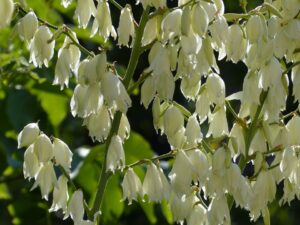How to Grow and Care for Yuccas

Yuccas are native to the southwestern United States and arid deserts growing in coastal sandy dunes of the east, rocky badlands, and grasslands. Yuccas belong to the family Asparagaceae which comprises some 40-50 species. The common name for yuccas is Adams needle. Most yuccas have thick waxy skins to avoid water loss.
Yuccas can reach heights of 4-8 ft growing in zones 5 to 10, this evergreen produces leaves that are tough with a sword-like shape. Yuccas produce beautiful white flowers that are a show stopper, what I love about yuccas is their low maintenance drought-tolerant plants that can grow both out and indoors. For more on yucca plant care let’s take a closer look.
The planting location
Install yuccas in an area that gets full sunlight.
The soil type
Because yuccas are native to desert and dry areas, soil that’s well-drained is ideal for yuccas to thrive. Yuccas are used to grow in sandy, gritty soils.
Water requirements
Because yuccas are drought-tolerant they don’t require much water, allow the soil to dry before another water application.
How to fertilize
Yuccas are slow growers requiring a few fertilizer application each year, a slow-release nitrogen balanced fertilizer will provide the right amount of nutrients.
Garden insect pests of yuccas
Yucca garden pests
- Yucca weevil
- Scale
- Aphids
- Agave plant bugs
- Two-spotted mites
- Mealybugs
Yucca weevil
The adult of the yucca beetle is one-half of an inch long, black with an elongated snout. The larva which is white grubs tunnels in the flower stalk base, leaves, and the heart of the yucca. There is no cure for this insect except to remove and thoroughly discard the plant. Avoid planting in that area for a few years to discourage re-infestation.
Scales
Scales are among sucking insects that dose damage by sucking the plant’s sap or fluids, scales resemble bumps or small lumps remaining in a stationary or fixed position. In server cases the entire plant leaves may be covered, the use of insecticidal soap or neem oil will bring control. Before applying read and followed the manufacturer’s directions for best results.
Aphids
Aphids are tiny insects that are pared shape doing the same damage as scales, aphids are among some of the easiest garden insect pests to control. A strong spray of water applied to the leaves continually will bring control.
Agave plant bugs
Agave insect pests are 1/2 inch (1.5 cm.), these bugs will pierce the leaves of garden plants extracting the fluids. Brown small scars appear in injured areas, insecticidal soap will bring control.
Two-spotted mites
Two-spotted mites are tiny barely visible to the eyes, mite cause damage by sucking the plant’s fluids. Signs that your plant has a mite issue are spider webbing on the leaves, to bring control apply neem oil or insecticidal soap.
Mealybugs
Mealybugs are easy to spot, these garden insect pests are sucking insects, their secretion or excrement is a sugary substance known as honeydew from which forms a black mold ( sooty mold). Sooty mold causes plants to take on a sickly dusty appearance. Applying insecticidal soap or other pesticides will bring control.
Yucca plant diseases
Diseases of yuccas
- Brown spots
- Gray leaf spots
- Stem rot
Brown spots
Brown spots show up as purple borders followed by tiny clear areas on the older leaves, if allowed to persist the spots cover the leaves turning yellow then brown. The removal of the older leaves including ones that are infected followed by applying a fungicide will offer some help.
Gray leaf spots
Gary leaf spots show up as spotting in the older leaves, removing infected plant parts, and applying a fungicide will offer help.
Stem rot
As the name says stem rot is the rotting of the stem that has a mushy discharge with a bad odor. This disease is caused by bacteria. To avoid stem root the use of potting soil along with sterilizing containers is a must.
How to prune yuccas
To keep your yucca with a healthy all-natural appearance, prune disease parts along with brown leaves. Parts of your yucca that are overgrown can be cut back to the desired size, flower stalk can also be cut back to the base after blooming.
Where to install your yuccas
- Yuccas can be installed indoors
- Can be used in a garden plant bed as a backdrop
- Install on either side of your door entrance
- Plant near a wall or fence area
- Installed as a stand-alone plant
- Use yuccas along your garden walk pathway
Growing yuccas indoors
When growing yuccas indoors, place them in an area that gets bright indirect sunlight, the container that is chosen should have drain holes and a saucer to catch water after application. The container however should be large enough to accommodate your yucca plant. Following the other steps as mentioned will ensure that you have a yucca that’s growing healthy.
The final word on yucca plant care
The yucca plant is amazing, easy to care for, and will give you what you are looking for, A garden beauty such as yuccas will bring that much-needed flavor into your garden and landscape area. Yuccas will go to work for you both out and indoors so give yuccas a try you will be so happy with the results.
About the author
Norman loves being in the garden, both at home and for his job....
he is 'Natures Little helper' being outdoors, growing his vegetables and flowers from an early age.
Now having spent over 22 years in the profession he want to give some of his knowledge to others...
his vast array of hints and tips you will find scattered over this site will help you no end growing plants in your garden.
